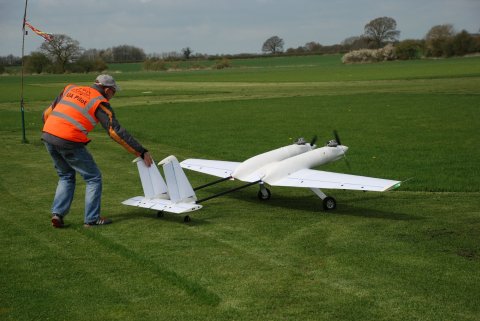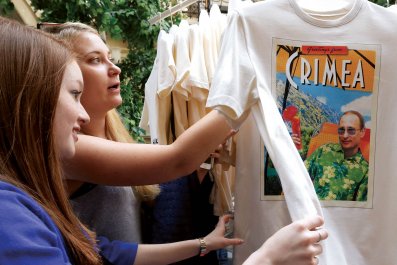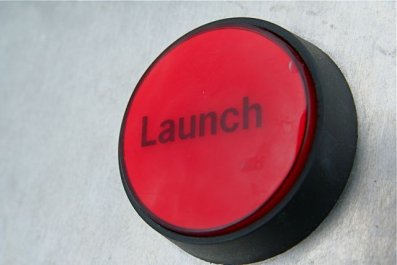On a bright, sunny afternoon on July 9th, a white unmanned air vehicle (UAV), its two 2.75 horsepower engines whirring, taxied smoothly down a finely mowed field of dark green grass. After a short distance, it lifted off and effortlessly soared to an altitude of 100 metres. It banked right, then began flying large, lazy circles above the rolling, grassy hills of the Wiltshire Downs in southern England.
After 10 minutes, the drone which has a wing span of around 4m – gently returned to Earth and taxied back to its ground crew. It was the second of 20 short test flights it made that day. For the first 14, the drone was controlled remotely by a pilot on the ground, but it flew the last six tests entirely on autopilot run from a laptop.
Small UAVs are already not an infrequent sight in the low altitudes of UK airspace, but what made this drone a rare bird was how it came into being: most of its key parts, including the fuselage and fuel tank, were fashioned in lightweight nylon by a 3D printer. Three years ago, University of Southampton researchers, led by Jim Scanlan, a professor of aerospace design, scored a world first when they built and flew a UAV constructed entirely from parts made by additive manufacturing, or 3D printing. That original UAV, four iterations ago, was smaller, with a 4-foot wingspan. Since then, Scanlan's team – armed with a £3m UK government grant – has been successfully working to prove that drones can be designed, built and tested in the relatively time-warp speed of less than two weeks using additive manufacturing.
But now Scanlan has set his sights on an even larger target. He wants to prove that the 52-pound, 3D-printed drone that swooped over the still-green wheat fields of Wilshire last week is a prototype for next-generation cargo planes.
"I strongly believe that all cargo aircraft will soon be unmanned," Scanlan says. More boldly, Scanlan also believes that large cargo planes –assembled from 3D-printed parts – can soon be plying the skies using inexpensive, off-the-shelf communications technologies, instead of relying on expensive, and yet-to-be developed, sense-and-avoid systems. But that's a view currently at odds with industry and regulatory agencies' thinking.
To prove his point, Scanlan's started a program called HIATUS, for Highlands and Islands Aerial Transport using Unmanned Systems, that he hopes will, within 18 months, use 3D-printed drones, each about half the size of a small Cessna and flying semi-autonomously, to ferry goods to remote islands in Europe that have poor transportation links and are often inaccessible because of fog and bad weather. "Our unmanned aircraft," he insists, "is perfectly happy flying in fog."
Scanlan is certainly riding the wave of an inevitable trend. "Drones will soon be part of everyone's lives," says Amanda Stainer, commercial director of the biennial Farnborough International Airshow, which runs from July 14th to 20th.
Underscoring that point: there will be 78 companies displaying UAV technologies at Farnborough this year, a nearly four-fold increase from the 22 that took part in the 2012 show. "It's pretty buzzing," she says of drone systems. "People obviously see it as the future." A 2012 report by US aviation consultants Teal Group estimated that, by 2022, annual spending on UAVs would jump from $6.6 billion to $11.4 billion, for a total of $89 billion over the decade.

So far, militaries have been the biggest developers and users of UAVs. Over the past decade, for instance, the US military's drone fleet has grown from less than 5% of all aircraft to more than 40%. But that's about to change. In September 2015, the US Federal Aviation Administration will introduce regulations allowing for UAVs in civil airspace, and it predicts 10,000 drones will be flying in American skies by 2017. Here in Britain, the unofficial target date to open civil airspace to larger drones is 2020. Initially, small UAVs are likely to be used for border surveillance, policing, monitoring sea lanes and inspecting farmlands.
But the real economic impact will come once large cargo carriers can go pilotless. The cargo industry is also eager to cut fuel costs and reduce its carbon footprint by using planes that are lighter and more efficient. That's why drones could be a welcome development, especially if they could largely be made more cheaply using 3D printers and strong but light material like nylon.
Planes without humans aboard don't need expensive, and heavy, life-support systems to keep cabins pressurised. UAVs also take pilot pay out of the economic equation, and that's the second biggest cost after fuel for commercial aircraft. And, Scanlan says, ultimately UAVs are safer, too. "Most airline crashes now are human errors, so let's get rid of the humans in the cockpit."
The Autonomous Systems Technology Related Airborne Evaluation and Assessment (Astraea) project – a three-year, £62m industry government-funded effort that's researching how best to allow UAVs and manned aircraft to share UK airspace – couldn't agree more. Last summer Astraea carried out test flights across Britain using a two-engine Jetstream prop plane that was remotely controlled from the ground, although an onboard human pilot handled the takeoffs and landings. It's now working with regulatory and standards organisations to craft a regulatory framework. But, unlike Scanlan, Astraea is convinced that for UAVs to fly safely among manned aircraft they need to have sense-and-avoid systems that allow them to "see" if another craft is in its flight path and autonomously man0euvre to avoid it.
The problem isn't having robotic planes in controlled airspace, says Lambert Dopping-Hepenstal, project director, but flying in the low-altitude "uncontrolled airspace" on the edge of an airfield. "It is more difficult in uncontrolled airspace, where anyone can fly – balloonists, gliders, parachutists – where we now depend on pilot response. You can't put a UAV in that airspace until you prove it is safe." Which is why there's a big push to develop avoidance systems, which, Dopping-Hepenstal admits, is a big technical challenge, though he thinks it is possible by 2020. "We are making decent strides on this."
Beyond developing sense-and-avoid technology, it's also necessary to figure out how to provide "absolutely secure" communications systems linking ground and plane, he says. Communications between controllers and pilots are currently unsecured, and anyone can listen in. But that can't be allowed to happen if sensitive data is traveling back and forth between the aircraft's autonomous system and the ground-based pilot who has ultimate control. "We cannot risk it being hacked," Dopping-Hepenstal says.
Scanlan, however, claims that, "the regulators have got it wrong". Avoidance systems are still far from from ready, "and they're a waste of time and too complicated." They're basically cameras, Scanlan notes, but cameras don't work in clouds or fog, "so what's the use of that?" Meanwhile, he says, all commercial planes now use transponders, passive radar systems, that enable them to "talk" to each other and avoid collisions in clouds. "Transponders work. They are done and dusted." The better option, he says, is to require other types of craft, like balloons and gliders, to be fitted with transponders, too.
Scanlan's Hiatus project will not only use transponder technology on its drones, but also a system it calls "airspace multiplexing", which means operating its UAVs during low-demand night hours and in poor weather to further reduce the chances they'll encounter other craft.
He believes that once he's got a small fleet of 3D printed drones up and flying safely without sense-and-avoid systems, he'll eventually convince regulators he's right, and can win approval to fly larger cargo jets in more populous areas. Says Scanlan: "The most convincing argument you can put to regulators is 'We've done 1,000 to 5,000 hours without incident, now let us try this in another area.'"






























